Elroy and the Aliens review
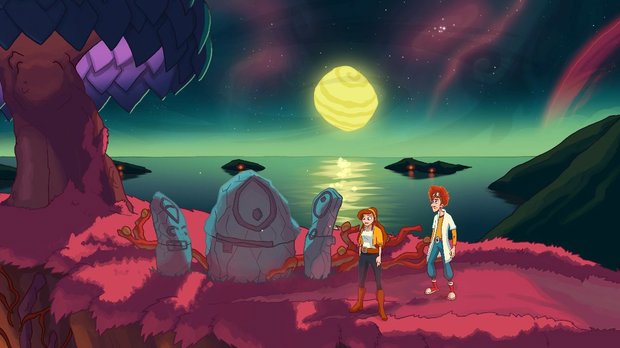
- 0 Comments
Delightful intergalactic cartoon point-and-click adventure rockets to surprisingly emotional heights
Losing a loved one is never easy. Whether it’s a parent, a spouse, a friend, or anyone in between, there’s little worse than a sudden, unexpected absence of someone important to your life. But what if you had the opportunity to bring them back? Would you travel across the universe to find them, or even across time? Elroy and the Aliens offers a surprisingly heartfelt “yes,” with plenty of charming characters and wacky scenarios along the way to provide a quirky dose of fun in this extraterrestrial adventure.
You play as Elroy Deluna, an engineering geek who has spent every last ounce of his savings to build a new kind of remote-controlled rocket. The story begins with Elroy being jolted awake by the sound of reporter Peggie Wolf with Slope City News knocking on his door. Elroy had been asked for an interview regarding the maiden voyage of his new prototype, and he accepted in the hopes that being front page news would be the springboard he needs to blast off into science stardom. Peggie, on the other hand, seems less invested in the business with the rocket and much more interested in the works of Elroy’s father, Diego Deluna. Diego was a famous archeologist who had written countless works detailing his discoveries, up until he vanished one day in 1975 without a trace. It’s been 18 years since his mysterious disappearance, and Elroy has been largely on his own ever since.
After a small mishap, Elroy manages to get his rocket lifted off and in the air before a strange electrical discharge erupts off Wanderbrust Tower, the tallest building in all of Slope City. This sends the rocket crashing through the roof of Elroy’s home, in the process unearthing a strange device hidden in the wall. Elroy and Peggie unlock the device, revealing a holographic recording left by Diego, stating he was betrayed and trapped by his business partner Cyril Wanderbrust (now mayor in 1993) in a far-off world through a legendary ancient structure. He says that Cyril brought back something dangerous to Earth, along with another thing called a Gate Crystal that serves as the only link between this world and the one Diego is trapped in. It’s now up to you to find this legendary structure, take back the Gate Crystal, and save Elroy’s father. Thankfully Elroy won’t be alone in his quest, as Peggie tells him she’s coming with him and will help in any way she can.
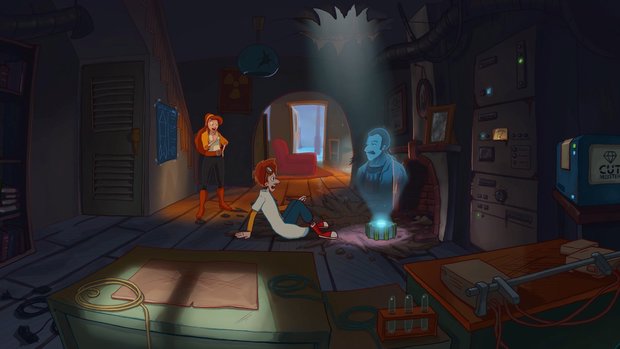
Elroy and the Aliens is a traditional point-and-click adventure, with all actions being handled via the mouse. The entirety of the game is controlled through a two-button interface, with left and right clicks having different functions. You can hover over characters, objects, and points of interest with your cursor and you will be given the options to observe (which provides your character’s thoughts on whatever you are looking at) or interact with them. There isn’t a run function, but you can double-click exits to quickly move to the next room or bring up a map. Whenever you leave an area, you will be transported to an animated map hub that lists all available locations you have discovered. There are multiple hub areas to uncover, and each provides a variety of locations to visit, traveling between each destination at your leisure.
Your inventory is hidden at the top of the screen, and hovering over it will let you look through the items you have collected. You will control either Elroy or Peggie based on where you’re at in the game, and they each have their own inventory. You can attempt to combine items in either inventory, and if successful, a short animation plays out of the two things being joined together and the new combination shown in the center of the screen. It’s not overly flashy, but it’s a fun little flourish. Along with the inventory, a settings button is available that allows you to save and load your progress (there’s an autosave that updates periodically that you can load here as well).
You will encounter a variety of characters throughout your 8-10 hour adventure, and will chat with them via dialogue trees of various options to talk about. Some topics are required to proceed but the majority are optional, to experience as much of or as little as you want. Not that you would want to skip any of the wonderfully written, superbly voiced dialogue in Elroy and the Aliens, as it’s all cartoony fun. So too are the many environmental details that help build out the world and feel of 1993 New Mexico. You’ll find computer screens displaying MS-DOS interfaces, and all of the televisions are beefy CRT models. It’s not all period piece accuracy, however, as helper robots are a common sight around Slope City. These are simple androids that look like trashcans with binocular eyes slapped onto a unicycle, but they have plenty of personality. It’s a vibrant, exaggerated take on sci-fi that meshes well with the extraterrestrial encounters you uncover as you delve deeper into the story.
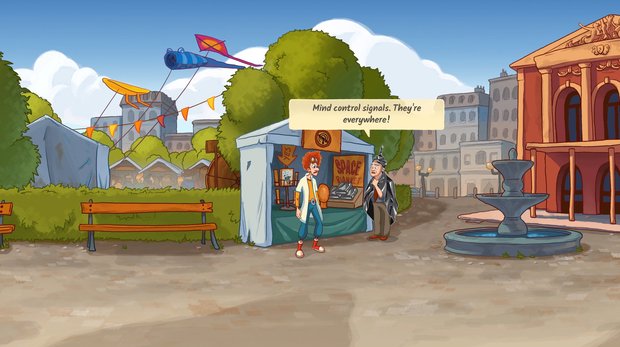
As with many other traditional adventure games, the majority of your time in Elroy and the Aliens will be spent gathering and combining items, and using them to solve puzzles. Typically an interactive object will be drawn in such a way to stand out against its backdrop, so it’s pretty difficult to miss one. There was only one instance where I could not figure out where an item was – a small hose dangling on the side of a wall that I assumed was a computer wire. If you find yourself having difficulties, there’s a handy option you can toggle on/off in the settings that enables a hotspot highlighter. While I personally did not find use for it apart from that one occasion, it’s a great feature to have available to help in a pinch.
Outside of item-based puzzles, you will also come across a variety of environmental obstacles. These are still controlled exclusively through your mouse, but typically they will require you to click and drag something in order to move an object. An early example of this has you clicking a crank and rotating your mouse in order to wind up a pulley to open a locked gate. There’s a wide range of objectives with these kinds of puzzles, and many are a one-and-done experience. Unfortunately, about halfway through the game these puzzles begin being recycled to the point of feeling more like padding than enjoyable brain teasers.
The most egregious examples are the hexagonal rune number puzzles that appear over five times. While the puzzle is different each time, they share the same basic structure of having to match up the edges of each numbered hexagonal rune with the correct number of adjacent runes (meaning, if the rune lists 2, you will need to have that rune touching exactly 2 adjacent runes). There are other puzzles repeated as well – one involving moving around mirrors to navigate a beam of light comes to mind. None of them are impossibly difficult by any means, but it’s a bit jarring coming from the usual item-based puzzles to a completely different style of puzzle multiple times.
Through much of Elroy and the Aliens, I had no trouble working out its challenges and the solutions to progress are never too outlandish. There’s no hint system per se, but you usually receive a bit of a nudge in the right direction if you examine your environment thoroughly. If you click on an object that is related to a puzzle, Elroy or Peggie will often note how they can use that object to perform a particular task if needed in the future (i.e. Elroy sees a solar panel with a charger port that he comments could be used to charge a battery if he needed to).
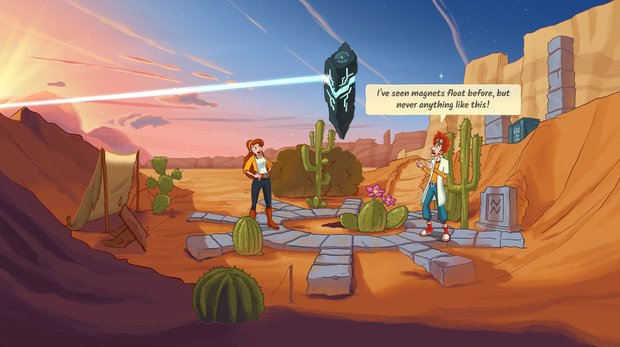
With that being said, I would be remiss not to mention the one point in the game where I came upon a puzzle that pushed me to my limits of sanity. After about two-thirds of the game, Elroy and Peggie are finally introduced to those aliens mentioned in the title. They’re friendly and have no ill will towards either character, but there’s one problem with your extraterrestrial encounter: none of the aliens speak any Earth languages, so you’ll need to learn theirs. You have to talk with the various aliens in a small area, while Peggie slowly pieces together how particular words are translated (mainly numbers). These are all spoken as nonsense phrases, so there’s no frame of reference other than what you hear spoken.
Eventually you’ll come upon three strange rocks that appear to resemble the aliens, and when interacting with them they will start repeating some of the same nonsense words to you. You have to then choose from the phrases you have learned to reply back to the alien rocks. The first response is always the same, but as far as I could tell the subsequent answers change each time. What’s worse is that you have to answer all of them correctly without any mistakes in order to progress, and one mistake means having to restart from the beginning.
Other than the first response, which I figured out relatively quickly, I could not for the life of me work out what the correct responses were for the rest. I walked around and spoke to every alien in the area multiple times, thinking I had missed something that would allow me to discover more responses to the rocks, but each time I would come back empty handed. Eventually I brute forced my way through this puzzle by trial and error, but I still have no idea what the actual solution was outside of guessing until I got it right. I don’t invoke the dreaded Monkey Kombat from Escape from Monkey Island lightly, but I had flashbacks to that infamous puzzle during this section.

Thankfully, the majority of Elroy and the Aliens is devoid of frustration like the alien language puzzle and can be solved through logical deductions and careful consideration of the items you have collected. This allows the story, characters and settings to shine, as you are guided along a sci-fi adventure that takes you to a diverse range of gorgeous locales, from Slope City to a mysterious ghost town wiped from history, all of them designed in a charming, beautifully animated hand-drawn art style.
Every location is a joy to explore, with subtle touches that make each environment feel distinct. One section of the game has you roaming the backstage dressing rooms for a less-than-stellar stage production, the walls covered with various costumes and props. When you finally arrive on the alien planet, you are greeted by a huge overlook of a nearby city of otherworldly structures, dotted by eyeball-stalked plants and flying vehicles streaking across the sky’s multiple moons. Each area you visit has its own hub map with moving parts, whether it’s cars driving around on the map of Slope City, or beams of light shooting across an ancient dig site as you uncover the mysteries held within long-dormant stone monoliths. Character movements are also meticulously animated, and you can tell the developers at Motiviti Games poured their hearts into the smallest details.
The same can be said of the musical score. The soundtrack is fun and adventurous, with a bombastic feel reminiscent of Back to the Future or any number of other blockbusters from the late 80s. There are two sections in particular that especially blew me away, where a full vocal performance accompanies the instruments – both being played during surprisingly emotional moments in a story about aliens and robots.
Unfortunately, this leads to some tonal inconsistency over the course of the game that really threw me for a loop whenever it came up. One moment you’ll be unburying a dead body to find a key item required for progression, and the next you’ll be scooping giant alien snail poop. There are some real emotional highs in this tale that I wasn’t expecting, but these are frequently undercut by tonal whiplash in moving from one set piece to the next. It’s never enough to derail the experience, and there’s nothing wrong with needing to scoop alien poop for the greater good of adventure gaming, but the game sometimes couldn’t seem to decide if it wanted to be a comedy or serious science fiction mystery.
Nevertheless, it’s a testament to the strength of the game’s core narrative that no matter how outlandish the environments got, I never lost my investment in the world and characters. At its core, Elroy and the Aliens is a story about Elroy doing whatever it takes to find out what happened to his dad, and by the end of the game, you find that even the literally mustache-twirling Mayor Cyril Wanderbrust has some surprisingly human reasons for all of the wrongs he has wrought as well. There are multiple endings based off a final decision Elroy has to make at the end of the game, and all of the options lead to some powerful emotional moments.
Final Verdict
After eleven years of development, Elroy and the Aliens does not disappoint. It’s a lovingly crafted adventure with plenty of stunning sights, memorable moments and clever puzzles. I would have liked to see less rehashing of certain non-inventory brain teasers in the second half of the game, and there’s a noticeable increase in difficulty during the last third, but it’s hard to dwell too negatively on these issues when so much of the experience is such a blast. Even with some of the more bizarre elements that populate its beautiful cartoon world, the relatable nature of Elroy and Peggie’s journey continually warmed my heart. I may have started playing for the promise of wacky alien shenanigans, but the moments that will stick with me the most are those grounded in humanity.
Hot take
Don’t let its delightfully cartoonish appearance fool you: Elroy and the Aliens is a wonderfully heartfelt point-and-click journey across time and space, about family connections and the lengths we’ll go to reunite with our loved ones.
Pros
- Gorgeous hand-drawn characters and environments with equally slick animations
- Heartfelt story brought to life by superb voice performances
- Stellar musical score, especially the standout vocal tracks
- Most puzzles have satisfying, logical solutions
Cons
- Major difficulty spikes during the last third of the game
- Non-inventory puzzles often recycled multiple times
- Story structure sometimes suffers from tonal whiplash
Sam played Elroy and the Aliens on PC using a review code provided by the game's publisher.


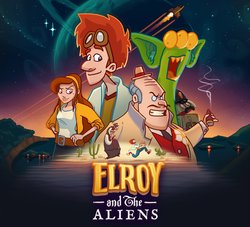








0 Comments
Want to join the discussion? Leave a comment as guest, sign in or register.
Leave a comment